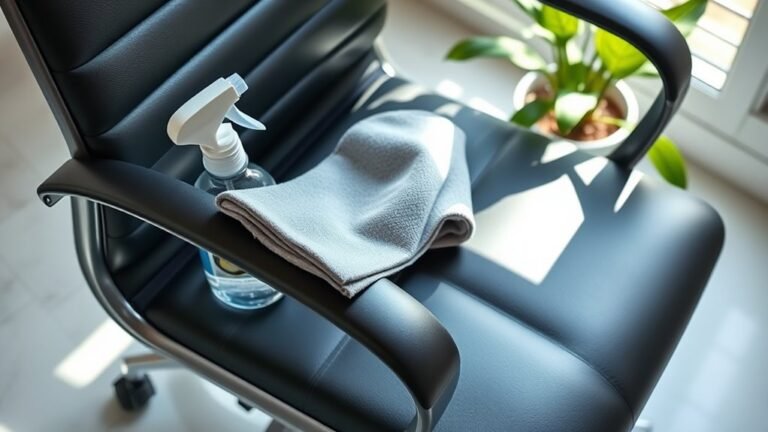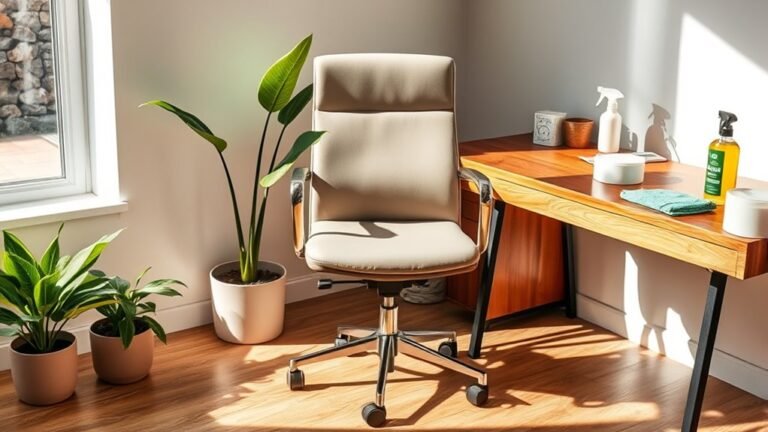Creating a Cleaning Schedule for a Busy Office
To create a cleaning schedule for your busy office, start by evaluating your space and identifying high-traffic, high-touch areas needing regular attention. Set realistic cleaning frequencies balancing daily tasks with periodic deep cleaning. Assign clear responsibilities among your team and choose efficient, eco-friendly supplies. Communicate the plan transparently and monitor its effectiveness, adjusting as needed. Encourage participation through incentives and shared accountability. There’s plenty more to explore for keeping your office spotless and running smoothly.
Assessing Your Office Cleaning Needs

How often do you really need your office cleaned? It depends on your office layout and how your team works within it. Open spaces with shared desks may need more frequent cleaning than private offices. You’ve got the freedom to tailor your cleaning schedule, but it starts by evaluating the actual needs. Don’t guess—gather employee feedback to understand which areas feel neglected or messy. Your team’s input will help you prioritize cleaning tasks and frequency, ensuring a healthier, more productive environment. By considering both the physical setup and your employees’ experiences, you’ll create a cleaning routine that doesn’t just keep the office tidy but supports the freedom to work comfortably and efficiently every day.
Identifying High-Traffic and High-Touch Areas
Three types of office spots demand your attention: high-traffic areas, high-touch surfaces, and shared spaces. To keep your cleaning efficient, start by analyzing your office’s traffic flow—notice where people naturally gather or pass through most often. Next, use touchpoint mapping to identify surfaces everyone interacts with regularly, like door handles, elevator buttons, and shared equipment. This process helps you pinpoint where germs and dirt build up fastest. By focusing on these critical zones, you free yourself from unnecessary cleaning elsewhere, saving time while maintaining a healthier environment. Recognizing these hotspots empowers you to target your efforts smartly, ensuring your cleaning schedule fits your busy office life without sacrificing cleanliness or freedom.
Setting Realistic Cleaning Frequency Targets

You’ll want to focus on cleaning high-traffic areas more often since they get dirty quickly. Balancing daily tasks like wiping down surfaces with weekly deep cleans keeps things manageable. Setting these realistic targets helps maintain a clean office without overwhelming your team.
Prioritize High-Traffic Areas
Because some areas in your office see more foot traffic than others, they need more frequent cleaning to maintain hygiene and appearance. Focus on high traffic surfaces like door handles, elevator buttons, and shared workstations when setting your cleaning priorities. These spots tend to accumulate germs quickly, so addressing them regularly helps keep everyone healthier and your space looking sharp. Don’t spread your cleaning efforts too thin—by prioritizing these key areas, you free yourself from unnecessary tasks and keep things manageable. This approach lets you maintain a clean environment without feeling trapped by endless chores, giving you the freedom to focus on what truly matters in your busy office. Keep your schedule realistic and targeted to stay efficient and effective.
Balance Daily and Weekly Tasks
While high-traffic areas demand daily attention, not every spot in your office needs such frequent cleaning. You can set realistic cleaning frequency targets by balancing daily checklists with weekly reviews. This approach frees you to focus effort where it matters most, without overburdening your team. Use daily checklists for tasks like wiping desks and emptying trash, and reserve weekly reviews for less urgent duties like deep-cleaning carpets or dusting vents. Here’s a simple guide to help you allocate tasks efficiently:
| Task Type | Frequency | Example Task |
|---|---|---|
| High-Traffic Area | Daily | Disinfect door handles |
| Shared Equipment | Daily | Clean keyboards |
| Office Spaces | Weekly | Dust shelves |
| Floors | Weekly | Vacuum carpets |
This balance keeps your office clean and your schedule manageable.
Assigning Responsibilities to Team Members
Assigning clear responsibilities to team members is key to keeping your office clean without overwhelming anyone. Start by defining specific team member roles based on strengths and preferences to guarantee tasks feel manageable and fair. To keep things fresh and avoid burnout, implement a responsibility rotation system—this lets everyone share duties like tidying common areas or restocking supplies. By rotating roles regularly, you prevent monotony and encourage a sense of ownership across the team. Make certain responsibilities are communicated clearly, so no one’s left guessing what they need to do. When everyone knows their exact part in the cleaning routine, it’s easier to maintain a tidy office without restricting anyone’s freedom or adding unnecessary pressure.
Choosing the Right Cleaning Supplies and Equipment

To keep your office spotless, you’ll need essential cleaning supplies and durable equipment that can handle daily use. Don’t forget to take into account eco-friendly products to reduce your environmental impact. Choosing the right tools makes the whole cleaning process more efficient and effective.
Essential Cleaning Supplies
Choosing the right cleaning supplies and equipment can make your office cleaning routine more efficient and effective. When you have the freedom to maintain a clean workspace without hassle, it boosts productivity and morale. To keep your supply inventory in check and complement your cleaning checklists, focus on essentials that handle daily messes quickly.
Here are four must-have cleaning supplies:
- Multipurpose cleaners for various surfaces, saving space and effort
- Microfiber cloths that trap dust and reduce waste
- Disinfectant wipes to keep germs at bay effortlessly
- Trash bags sized right for your office bins, ensuring quick disposal
Durable Cleaning Equipment
While having the right cleaning supplies is essential, using durable cleaning equipment guarantees your efforts last longer and work more efficiently. When choosing gear, consider commercial vacuuming solutions designed for heavy use—they save time and handle diverse floor types with ease. Ergonomic cleaning tools are another must-have, reducing strain so you can move freely and maintain momentum without fatigue. Investing in sturdy mops, brushes, and microfiber cloths means less frequent replacements, keeping your schedule hassle-free. By selecting equipment built for durability and comfort, you gain more control over your cleaning routine, freeing up time for what truly matters. Remember, the right tools don’t just clean better—they empower you to keep your office spotless without unnecessary effort or interruptions.
Eco-Friendly Product Options
Durable equipment will only take you so far if the products you use aren’t safe for the environment or your health. Choosing eco friendly alternatives helps you protect the planet while keeping your workspace fresh. Look for items that come in sustainable packaging to reduce waste and embrace products made from natural, non-toxic ingredients. This way, you’re not just cleaning but also supporting a cleaner future.
Here are some tips to keep freedom and responsibility balanced:
- Opt for refillable containers to cut down on single-use plastics
- Choose biodegradable cleaning agents that break down safely
- Use microfiber cloths that last longer and require less detergent
- Select products certified by trusted eco-labels for assured impact
Integrating Cleaning Tasks Into Daily Routines
To keep a busy office clean without overwhelming your team, you’ll want to weave small cleaning tasks into daily routines. By doing this, cleaning becomes effortless and part of everyone’s day, freeing up time for more important work. Use daily checklists to track these tasks, ensuring consistency without micromanagement. Here’s a simple way to integrate cleaning routines:
| Time of Day | Task |
|---|---|
| Morning | Wipe down desks |
| Midday | Empty trash bins |
| Afternoon | Sanitize keyboards |
| End of Day | Tidy common areas |
This approach keeps your office fresh and fosters a sense of shared responsibility. With these small habits, you gain freedom from clutter and enjoy a productive, clean workspace every day.
Scheduling Deep Cleaning Sessions
Since daily cleaning handles the basics, scheduling deep cleaning sessions guarantees your office stays thoroughly sanitized and well-maintained. You’ll want to incorporate deep cleaning techniques that target hidden dirt and buildup, freeing your workspace from grime and allergens. Seasonal cleaning strategies help you align these sessions with natural breaks or slower periods, maximizing efficiency without disrupting workflow.
Consider these points when planning:
- Rotate focus areas to cover carpets, upholstery, vents, and behind equipment.
- Schedule sessions quarterly or biannually to maintain freshness.
- Use eco-friendly products to keep the environment safe and healthy.
- Coordinate with your team to minimize interference and guarantee access.
Communicating the Cleaning Plan to Staff
How do you guarantee everyone understands the cleaning plan and their role in it? Clear cleaning communication is your key. Start by sharing the schedule openly through emails, team chats, or posted notices where everyone can easily access them. Make it simple and straightforward—no need for complicated jargon. Encourage staff engagement by inviting feedback and questions, letting them feel part of the process rather than just following orders. When people see how their efforts contribute to a cleaner, healthier workspace, they’re more likely to stick with it. Remember, your goal is freedom from confusion and missed tasks, so keep communication consistent and transparent. This way, everyone knows what’s expected, and the cleaning plan becomes a shared mission, not a chore.
Monitoring and Adjusting the Cleaning Schedule
Although setting a cleaning schedule is essential, regularly monitoring its effectiveness guarantees it actually works for your office. You want a system that adapts to your team’s needs without feeling rigid. Keeping tabs on cleaning effectiveness assures spaces stay fresh and inviting, while schedule flexibility lets you tweak timing or tasks as demands shift.
To keep your cleaning plan on point, consider:
- Collecting feedback from staff about cleanliness and timing
- Tracking high-traffic areas that may need extra attention
- Reviewing cleaning logs to spot missed tasks or patterns
- Adjusting frequency or methods based on real-world results
Encouraging Employee Participation and Accountability
Keeping your cleaning schedule effective depends a lot on everyone doing their part. To encourage employee participation and accountability, create a culture where team collaboration feels natural, not forced. You can introduce cleaning incentives that reward consistent effort and make the process more enjoyable. Consider simple perks like recognition, small prizes, or casual competitions that spark friendly motivation. Make sure roles are clear but flexible, so everyone feels empowered rather than restricted. When employees see their contributions directly impact the office environment, they’re more likely to own their responsibilities. By fostering open communication and shared goals, you’ll build a sense of freedom within the team, making cleaning a collective effort instead of a chore. This approach keeps your schedule running smoothly without micromanagement.
Frequently Asked Questions
How Can I Handle Cleaning During Flu Season?
Think of flu season like a storm you can’t control, but you can prepare for. You’ll want to ramp up flu prevention by reinforcing sanitization protocols—regularly disinfect high-touch surfaces and provide hand sanitizers everywhere. Encourage your team to stay home if they’re sick and promote good hygiene habits. This way, you keep the office safe without feeling trapped, giving everyone the freedom to work healthy and worry less.
What Are Eco-Friendly Cleaning Product Alternatives?
If you want to keep things green, natural cleaners are your best bet. They use ingredients like vinegar, baking soda, and essential oils, which are gentle but effective. By choosing these, you’re embracing sustainable practices that reduce chemical waste and protect your health. You don’t have to sacrifice cleanliness for eco-friendliness—you can have both, freeing yourself from harsh toxins and helping the planet at the same time.
How Do I Manage Cleaning if Employees Work Remotely?
If your team works remotely, you can still keep your remote office spotless by creating a simple cleaning checklist. Share it with whoever uses the space, so they know exactly what to tackle and when. This way, you’re not tied down by constant oversight but still enjoy a fresh environment. Giving everyone freedom with clear expectations makes maintaining cleanliness easy and stress-free, even when no one’s physically there all the time.
Can Professional Cleaning Services Be Integrated Into the Schedule?
Imagine walking into a spotless space without lifting a finger—that’s the magic professional cleaning services bring. You can absolutely integrate them into your routine, tailoring cleaning frequency to match your needs and budget. This way, you gain freedom from daily chores while keeping costs transparent and manageable. By scheduling regular visits, you guarantee your environment stays fresh, freeing you to focus on what truly matters without worrying about the mess.
What Are the Best Practices for Disinfecting Shared Electronics?
When disinfecting shared devices, you’ll want to follow some key sanitizing tips. First, always power off the device and unplug it to avoid damage. Use a soft cloth lightly dampened with a 70% isopropyl alcohol solution—don’t spray directly. Focus on high-touch areas like keyboards, touchscreens, and mice. Avoid harsh chemicals that can ruin electronics. By keeping these shared devices clean, you’re protecting yourself and others while keeping your freedom to work worry-free.






